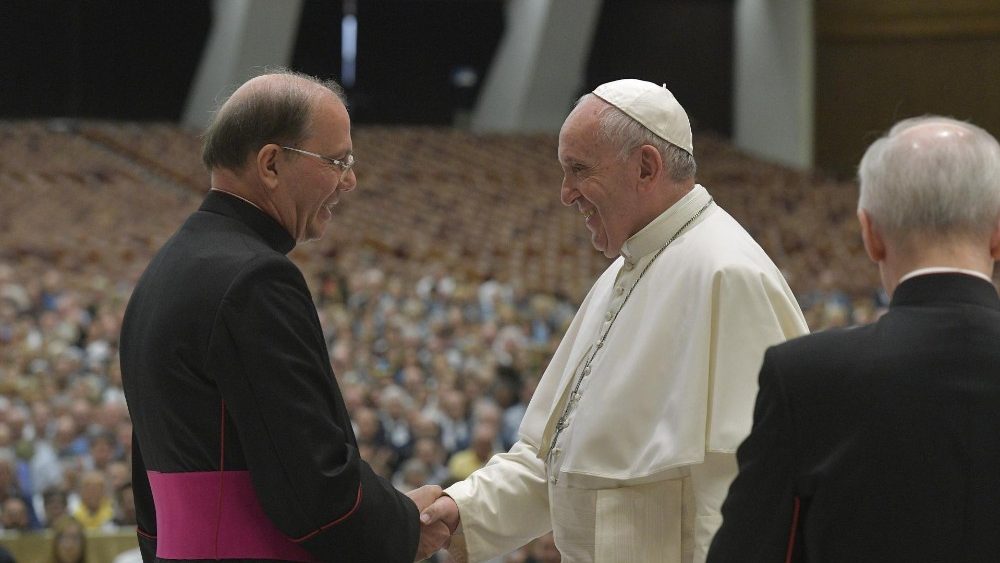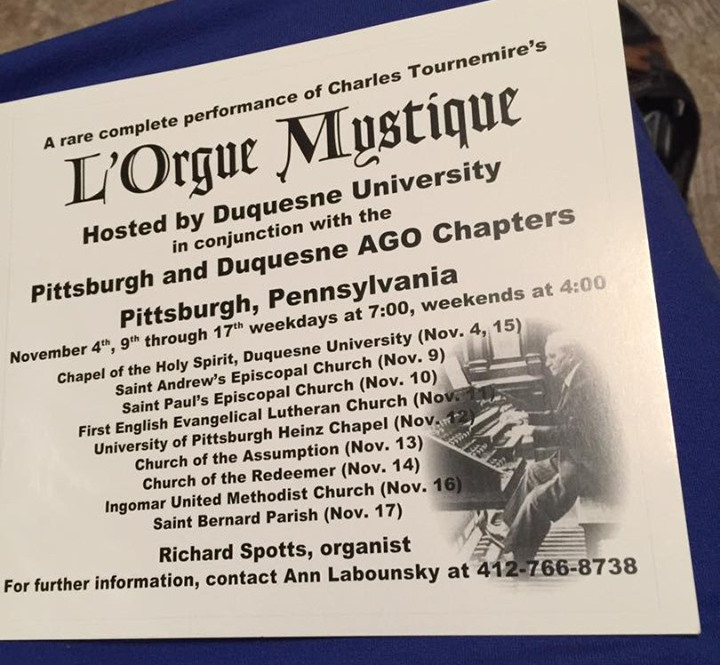Musicians looking for an educational event next February may like to consider a conference NPM is putting on February 10-12 in Washington, with Dr. Peter Latona, the director of music at the National Shrine of the Immaculate Conception in D.C. The program includes four talks by Dr. Latona, two of them at the Basilica, and features the opportunity to observe a choir rehearsal on site. More information on the program, costs, and accommodations are in the event brochure.
New Office hymn texts in English
For several years work has been underway to develop a new edition of the Liturgy of the Hours (LOTH) in English for use in the United States. The version currently in use dates from the mid-1970s and is overdue for revision, since the second post-conciliar Latin edition was issued 34 years ago. So the new edition is coming with numerous positive changes, many of them based on the 2001 document Liturgiam authenticam.
One part of the work has reached a milestone: the task of translating the office’s Latin hymns into English has been completed by the International Commission on English in the Liturgy (ICEL) and the results will be up for approval by the US bishops this month at their meeting.
These are great hymns, nearly 300 of them, full of theological significance and suited to the various feasts and daily observances, so they will be a true enrichment for the Liturgy of the Hours. They will replace the English-language hymns, songs, and poems that were used in the current edition, nearly all of them unrelated to the corresponding Latin texts.
As with most things in the world of church music, there is debate. Happily, the hymns are being put into English with an eye to preserving the original meter of the Latin hymns. This will make it so that the original melodies, simple Gregorian tunes, can be used with them. But in a move that inspires misgivings, the hymns are being rendered as unrhymed text.
Here’s an example:
Verbum Patris altíssimi,
Lux lucis invisíbilis,
Custos tuórum pérvigil :
Tu fabricátor ómnium
Discrétor atque témporum,
Fessa labore córpora
Noctis quiéte récrea.
Qui frangis ima tártara,
Tu nos ab hoste líbera,
Ne váleat sedúcere
Tuo redémptos sánguine,
Ut, dum graváti córpore
Brevi manémus témpore,
Sic caro nostra dórmiat
Ut mens sopórem nésciat.
Iesu, tibi sit glória,
Qui morte victa prænites,
Cum Patre et almo Spíritu,
In sempitérna sæcula.
Demo videos from ICEL for nine of the new hymn texts are available on the net.
Of course, the decision to avoid rhyme in the English translations of these hymns was not made without reason. In some cases, obtaining a rhyme can force the translator to change conventional English word order. This is commonplace in hymnody and poetry, but, it is said, it could arguably make the text seem artificial for the many clergy who observe the daily office alone, who read it rather then singing it.
One must concede that that is a reason, but it reflects a sad state of affairs: that now, as in the liturgical reform of the 1960s, the celebration of the liturgy with music is treated as something good but secondary, as somewhat less important than the desire to celebrate the liturgy in merely spoken form.
As a consolation, I am told that the new unrhymed English hymns will not be mandatory: that it will be permitted to use other translations, including the classic rhyming translations by greats such as Neale and Winkworth, or more recently those from the nuns of St. Cecilia’s Abbey in Ryde or Stanbrook Abbey.
More information on the status of the LOTH is available at the site of the USCCB.
Franciscus, vir catholicus
Before October is out, here’s an office antiphon in honor of St. Francis of Assisi, sung in a church in northern Italy:
Franciscus, vir catholicus
et totus apostolicus,
Ecclesiae teneri
fidem Romanae docuit,
Presbyterosque monuit
prae cunctis revereri.
Francis, a man Catholic and entirely apostolic,
taught that the faith of the Roman Church be upheld,
and admonished that priests be revered before all.
It’s unusual in that it’s rhymed (aabccb, 887777): for more information about the source in a Franciscan antiphonary, see this page at Boston College Libraries.
St. John Henry Newman
A glance at some of the observances surrounding the canonization of St. John Henry Newman:
The London Oratory Schola Cantorum sang at Sunday’s canonization Mass in Rome, under the direction of Charles Cole:
Fr. James Bradley of the Ordinariate of Our Lady of Walsingham appeared on EWTN (Great Britain) in a series of reflections about Newman’s life and importance:
And Mass at the Oratory itself was followed by a solemn Te Deum:
The Ukrainian Catholic SingCon
In September, CMAA board member David Hughes and I had the pleasure of attending the second annual “singing conference” for musicians of the Ukrainian Greek-Catholic Church held at St. Basil Seminary in Stamford, Connecticut, presented by the Patriarchal Liturgical Commission of the UGCC. For us Westerners, it was a beginner’s opportunity to become acquainted with the music of that Church, characterized by its traditions of harmonized chant.
For the eighty or so attending, it was a time to share with each other their experience as parish musicians and to learn from recognized experts, many of them connected with St. Basil Seminary or with the Sheptytsky Institute based in Toronto.

The program included sung celebrations of Vespers, Matins, some of the Little Hours, and of course Divine Liturgy, which on Sunday was celebrated by Bishop Bohdan Danylo of Parma, Ohio. That liturgy included some works by New York-based composer Roman Hurko, who directed one of the choirs at the “SingCon”:
Next year the conference will be held at the Ukrainian Catholic cathedral in Philadelphia, October 1-4.
More information and videos from this year’s conference appear at our sister site New Liturgical Movement and at the site of the Patriarchal Liturgical Commission.
Pope Francis: take Gregorian chant “as the first model” of sacred music

Address of the Holy Father Francis to the Scholae Cantorum of the Italian Saint Cecilia Association
Paul VI Audience Hall
Saturday, September 28, 2019
Dear brothers and sisters,
I welcome all of you, the president Monsignor Tarcisio Cola, whom I thank for his words; the Board of Directors, and you, cantors, choir directors, organists, who have come from the various parts of Italy.
You are part of the meritorious Italian Saint Cecilia Association, 140 years old from its foundation and still alive and working and desiring to serve the Church. The affection and esteem of the Pope for this Association are well known, in particular St. Pius X, who gave the people of God a synthesis of teaching on sacred music (cf. Motu Proprio Tra le sollecitudini, November 22, 1903). St. Paul VI wanted you to be renewed and active for a music that is integrated with the liturgy and draws its fundamental characteristics from it. Not just any music, but a holy music, because the rites are holy; adorned with nobility of art, because for God we must give the best; universal, so that everyone can understand and celebrate. Especially, it should be well distinct and different from the music used for other purposes. And he recommended that you cultivate the sensus ecclesiae, discernment of music for the liturgy. He said, “Not everything is valid, not everything is lawful, not everything is good. Here the sacred music must be joined with the beautiful in a harmonious and devout synthesis.” (Discourse to religious women dedicated to liturgical chant, April 15, 1971). Benedict XVI exhorted you to not forget the musical heritage of the past, to renew it and increase it with new compositions.
Dear friends, I too encourage you to continue on this road. To be an Association is a resource: it helps you to generate movement, interest, commitment to better serve the liturgy. An Association that is not the originator or owner of any music, but has love and fidelity to the Church as its program. Together you can devote yourselves better to song as an integral part of the Liturgy, with Gregorian chant inspiring you as the first model. Take care together for artistic and liturgical preparation, and promote the presence of the schola cantorum in every parish community. In fact, the choir guides the assembly, and with its own specific repertoire, is a skilled voice of spirituality, of community, of tradition, and of liturgical culture. I recommend that you help the whole people of God to sing, with conscious and active participation and in the Liturgy. This is important: closeness to the people of God.
The fields of your apostolate are various: the composition of new melodies, promoting chant in seminaries and houses of religious formation; supporting parish choirs, organists, schools of sacred music, and youth. To sing, to play, to compose, to direct, to make music in the Church are among the most things for the glory of God. It is a privilege, a gift of God, to express musical art and aid participation in the divine mysteries. A beautiful and good music is a privileged instrument for approaching the transcendent, and often helps even distracted people understand a message.
I know that your preparation involves sacrifices connected with finding time to devote to practice, with getting people involved, with carrying out feast days when perhaps your friends invite you to come and have fun. So many times! But your dedication to the liturgy and to its music represent a way of evangelization at all levels, from children to adults. The Liturgy is in fact the first “teacher” of catechism. Don’t forget this: the Liturgy is the first “teacher” of catechism.
Sacred music also reveals another duty, that of joining Christian history together: in the Liturgy resound Gregorian chant, polyphony, congregational song, and music of the present day. It is as though all the generations, past and present, were there to praise God, each with its own sensibility. What is more, sacred music and music in general builds bridges, brings people closer, even those far away; it knows no barriers of nationality, ethnicity, skin color, but draws in everyone, in a higher language, and always succeeds in bringing into harmony people and groups, even of very different origins. Sacred music brings people closer, even with brothers to whom we sometimes do not feel close. For this reason, the singing group in every parish is a group where there is an atmosphere of availability and mutual help.
For all of this, dear brothers, I thank you and encourage you. The Lord help you to be constant in your commitment. The Church esteems the service that you present in the community: you help it to feel the attraction of the beautiful, which detoxifies us from mediocrity, lifts us higher, toward God, and unites hearts in praise and in tenderness. I bless you and all the members of the Saint Cecilia Association. May our Lady protect you. And since he who sings prays twice, I trust that you will also pray for me. Thank you!
(translation by RC from the Italian original text, edited)
Tournemire in Pittsburgh
This November, the city of three rivers is to be favored with a full performance of L’Orgue Mystique, the chant-inspired suite of works by Charles Tournemire. Organist Richard Spotts will be performing from the collection on November 4 and again daily from November 9 to 17 at various churches in the Pittsburgh area.
Ann Labounsky, professor of organ at Duquesne University, appeared with Mr. Spotts in a short video about the event. (I hope it’s visible to everyone.)

